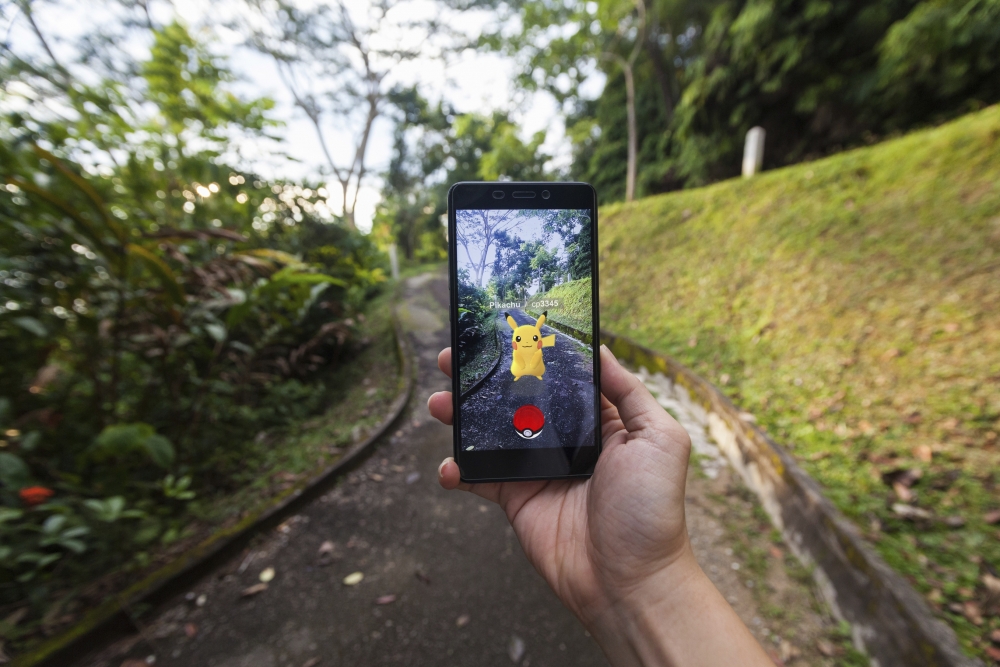
Catch ’em All


It’s reality and fantasy rolled into one: You’re walking down the street, looking at your smartphone, and suddenly you come face to screen with a little monster. It’s cute — it looks like a turtle, or a mouse or a fox.
Tapping your phone screen, you throw tiny balls at the creature until you strike and capture it. Voila, you now have a virtual pet you can train and send on missions. Or you can join teams, evolve your creature, collect items and fight for the prestige of your gym.
And all you really need are comfortable shoes and a smartphone with a lot of juice.
This is the world of Pokémon Go, the wildly popular augmented reality mobile game by San Francisco-based software developer Niantic, based on characters created by the gaming software company Nintendo. Part Easter egg hunt — on a massive scale — and part global capture-the-flag — with a touch of simulation — Pokémon Go has multitudes of people everywhere scouring their neighborhoods and local haunts — and checking out new places — in search of these cuddly characters. So popular is Pokémon Go that in just a few weeks after its release, usage of the web-based game handily outpaced that of internet giants Netflix, YouTube and Facebook.
“It’s a compelling platform,” said Debra Lieberman, a media researcher at UCSB and director of the campus’s Center for Digital Games Research. The center investigates how people interact with digital media and games and how to design these media to be highly engaging, beneficial and impactful.
“Compelling” is almost an understatement. News reports abound of people roaming neighborhoods or gathering in large groups to play; quitting their jobs (or getting fired) over play time; and traveling to places they would never otherwise visit just to capture one of the pocket monsters.
According to Lieberman, the viral appeal of this game fits nicely within the framework of Self-Determination Theory, which explains how people are attracted to and motivated by activities that enable them to be autonomous, competent and/or connected socially with others.
“Pokémon Go provides all three of these features to create a highly enjoyable experience that taps into players’ deep-seated, intrinsic needs and interests,” Lieberman said. “For example, the game includes several social features that foster interactions with other players who meet face-to-face while playing and already share common interests — in the game, in the characters — and they are able to play together in teams.”
The game uses other incentives and rewards that can be motivating, according to Lieberman. “Some of the rewards are related to the intrinsic interests of certain players, such as those who are health-minded. The game keeps track of the distance they have walked during current and previous game play, and this information is useful to them and they feel proud when they have made good progress.
“On the other hand,” she continued, “some game rewards are extrinsic and externally driven. They occur, for instance, when players rack up points or are awarded medals. Extrinsic rewards like these can be motivating, but usually only in the short term, and they can backfire and reduce motivation.”
As players have been eager to jump into the game, others have also been quick to realize the potential for location-based game elements, which have resulted in a variety of consequences, both intended and not. Businesses, in particular, have been using the game’s lures and incense to attract the creatures — and the players who are looking for them. Or they advertise their status as a “PokeStop” where players may collect necessary items for their quest. Elsewhere, less savory humans do the same to tempt unwary players into places where they might be robbed, or worse.
And that raises questions about whether players are trading more activity for less safety. Increases in game-related personal injuries and driving accidents are evidence that it can be a dangerous digital distraction if players are not mindful.
Also, what are players missing when they are so immersed in their screens? They might be getting out and about, but are they really engaging with their surroundings? “Some social critics and psychologists are concerned that Pokémon Go could be adding yet another way to see the world through our digital devices instead of through direct experience,” said Lieberman. “How might time spent in digital life influence the health and the quality of life of individuals and society? These are important issues to explore further.”
Meanwhile, the viral popularity of the free-to-play game has raised concerns about cybersecurity. Players must provide location and, in some cases, personal information (when signing in through a Google account, for example), which creates the very real potential for leaked information. What’s more, hackers seeking to cash in on the phenomenon have created fake companion apps or launched an attack on the servers.
“The minute it became so popular our concern was that if there was a social component, if there was a way to see where your friends are, then it’s entirely possible for someone to spoof devices and apps, get into the system, and at a large scale, pull down data about where users are,” said UCSB computer science professor Ben Zhao, who studies systems, algorithms, networking and data. Zhao, along with his students, recently proved that the popular community-based navigation app Waze was vulnerable to hacking by creating fake accounts to intercept information between Waze users.
But Pokémon Go itself presents little risk of information leaks, according to Zhao. The game’s social component exists in the real world, with teams of friends, and not in players’ phones. “What’s interesting about Pokémon Go is that every single user, at least as it is right now, is completely isolated in their own world in almost every aspect of the game,” Zhao said. Save for the gym battles, which are fought between teams, as opposed to individual users, players have no contact with each other, and therefore create no opportunities for attackers.
This makes Pokémon Go quite different from the more typical online games in which multiple players are isolated in the real world and their characters interact in the virtual world either in teams or pitted against each other, such as in the popular games EverQuest or World of Warcraft. “It’s strange for the reverse to happen, which is that you’re physically walking around outside of the building together as a group of people and yet inside the game you don’t see each other at all,” Zhao said.
However, that is likely to change, added Zhao, who focuses his research on systems with enormous sets of data, such as social networks. An online game may at first attract huge numbers of players, but anyone who has played a popular online game knows that after a certain period of time interest will drop off, either because the play gets too difficult, or becomes redundant. To maintain interest, the game’s publishers must add new features, and a particularly powerful one is the online social component.
“The thing about the social aspect of things is that it’s sticky,” Zhao said “A lot of people stay on Facebook because everybody else you know is on it and they all talk there and if you’re not there you miss out. So there’s fear of missing out. In games it’s the same thing.”
Already players have been clamoring for the ability to trade Pokémon with friends, or battle it out with other players. This, in turn, could open up problems with information leakage as hackers spoof devices that lure players into interacting with these malicious scripts.
Still, there are ways of protecting user privacy, Zhao noted. One would be to limit online interactions to an exclusive list of friends with whom a player will share their information. A virtual Pokémon free-for-all may be more fun, he said, but that may lead to far more issues than Niantic’s already overtaxed servers could handle.
Lieberman promotes the same kind of vigilance over the game as it continues to capture the attention of people everywhere. As with any popular and wide-reaching piece of digital media, the opportunity to insert messages could be huge, whether they are political views or product advertisements.
“If Pokémon Go ever expands to include online social interaction or allows in-game advertisements, I would be concerned about blurring the line between a fun fantasy story and one long ad,” she said. “Kids are particularly vulnerable to persuasive messages, especially before age 8 because they are less able to distinguish between fantasy and reality and they tend not to detect persuasive content. They’re more open and trusting. Many online social networks, especially those geared to children, have implemented safeguards, but it is always wise for consumers to be savvy and aware.”



